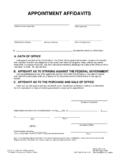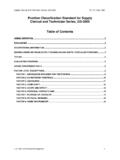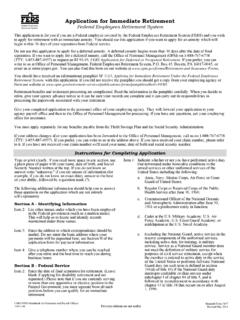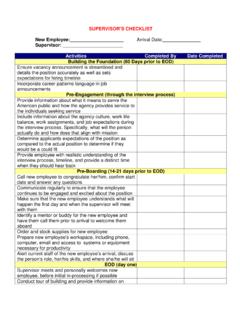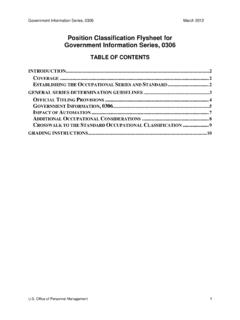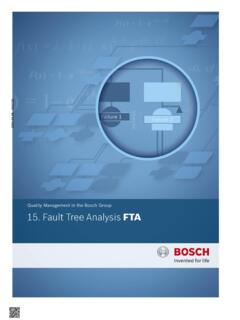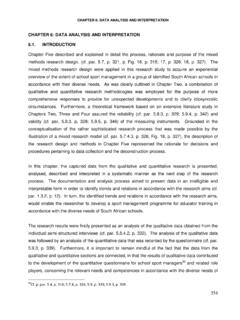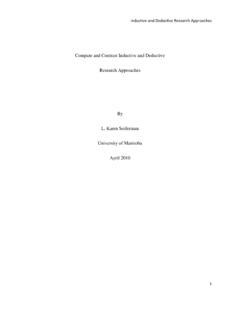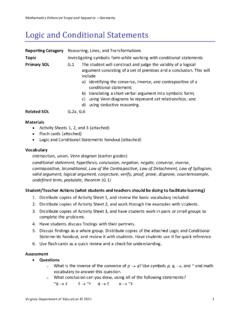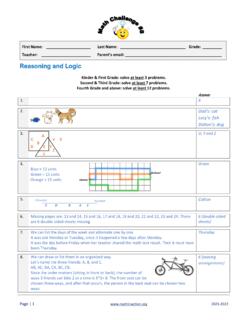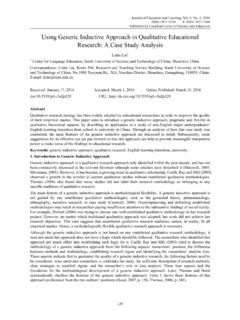Transcription of Scenario-Based Workforce Planning - OPM.gov
1 1 | Page Scenario-Based Workforce Planning Executive Summary There are a variety of tools and approaches available for organizations to use in Planning and developing their Workforce . Scenario-Based Workforce Planning is one of those methods. As an executive or manager involved in strategic Planning or as a human resources (HR) professional, using Scenario-Based Workforce Planning can improve the organizations effectiveness. This guide provides some recommended steps to help with your agency s Workforce Planning process. It is organized into the following sections: (1) background and uses for Scenario-Based Workforce Planning and (2) how to apply Scenario-Based Workforce Planning . A list of additional information about Scenario-Based Workforce Planning is also included. What is Scenario-Based Workforce Planning ? Scenario Planning is a method used during the strategic Planning process. scenarios are developed in the form of stories with characters and plots to illustrate possible futures in a compelling manner.
2 They encourage decision makers to imagine possible future events in the environment. Why use scenarios in Workforce Planning ? The purpose of Scenario-Based Planning is to help develop information to plan for unforeseen and foreseeable events. Helps leadership make informed decisions about how to best (strategically and methodically) allocate resources, train staff, etc. in preparation for what lies ahead. scenarios assist leaders with Planning for the future by developing options for what may lay ahead. Many organizations create and use scenarios to encourage more flexible, diverse thinking about their futures and create awareness and readiness. Organizations use scenarios to help organizational members: Envision possible and plausible future conditions Shift their thinking about the external environment Consider how future conditions will affect their organization scenarios are stories about the future that help people break through mental blocks and assumptions.
3 Ringland, 1998, p. ix The Mont Fleur scenarios Planners used the scenario methodology to explore possibilities for transforming South Africa at the end of apartheid. In 1991, a group met at the Mont Fleur Conference Center in South Africa to create scenarios about what the country could look like in 2002. The group compiled 30 possible stories about the next decade and reduced these to 4 that were plausible and internally consistent. 2 | Page 1. Project Preparation 2. Scenario Exploration 3. Scenario Development 4. Scenario Application 5. Project Evaluation Think of alternative responses Imagine the consequences of actions and decisions Develop long-range plans and contingency plans Assess ramifications for Workforce and competency requirements Develop skills gap closing strategies Develop anticipated budgeting requirements Organizations can test the viability of Workforce plans against scenarios to identify weaknesses in their plans.
4 They can compare Workforce requirements for different scenarios to find similarities and dissimilarities in Workforce needs and develop a reasonable range of plans Qualitative Planning techniques, such as scenario Planning , can help organizations go beyond merely extending trends based on past quantitative data. How do you develop and use scenarios for Workforce Planning ? In the following, we focus on five key steps to Scenario-Based Workforce Planning . 3 | Page Step 1. Project Preparation Identify the purpose of the scenario project. If you do not already know, start by finding out why the originator or sponsor for the project wants to use scenario Planning . This phase may include interviews, meetings, or a workshop with project sponsors and other stakeholders and a review of reports and documents. Key questions include: What has motivated interest in using scenario Planning ? What is the key issue or question that is the project s focus?
5 What decisions have to be faced? What are the biggest uncertainties? What are the expected outcomes for the scenario project? What do sponsors and stakeholders expect to get out of it? scenarios need to have a central purpose or question, or they will lack focus and internal consistency. The focal question puts scenarios into context (Chermack, 2011; Ringland, 1998). Researchers report that a lack of purposefulness is a major reason for scenario project failure. Thus, establishing a clear purpose and focal decision or question to guide the project is an important step for improving the likelihood the project will succeed (Chermack, 2011). In the case of Workforce Planning , example focal questions may begin with something like, What size and type of Workforce will we need in the future to fulfill our organizational strategy? or What Workforce plans will make us more flexible and agile in responding to a range of likely alternative future scenarios ?
6 The Australian Public Service (APS, 2011) frames a question that may be a useful focal point: What does your organization need from its Workforce capacity and capability to deliver its business outcomes now and into the future? Build the scenario team. Scenario Planning is a participative group process. Select a team that represents the organization and lends credibility to the project and its results. The process of interviewing stakeholders and selecting team members can help you build organizational support for the project. Involve key decision makers directly and on an ongoing basis. Participants should include people with a thorough knowledge of the agency and its issues (Ogilvy and Schwartz, 2004). The team should include people who are unorthodox and challenging thinkers from inside and outside the organization. The team should be diverse and reflect differing: Levels, perspectives, and roles Cultures Intellectual disciplines and functions Programmatic functions Strategic and core/operational functions 4 | Page Some questions to consider when forming a team include: Who has the leadership and facilitation skills to lead the team?
7 What individuals have the creativity and openness to envision and create alternative future scenarios ? What different parts or functions of the organization need to be included to develop a broad and realistic understanding of how scenarios will affect the organization and Workforce ? Who has the writing skills to complete scenarios ? Who has the availability and motivation to commit to being part of the team? Develop a project plan. The plan should build agreement between the project leader and organizational decision makers. The following checklist can help you develop a complete project plan Check if Completed Project Plan Element Identify the purpose and focal question of the scenario project Clarify the expected outcomes of the scenario project Select and develop measures you will collect during the project to assess achievement of the expected outcomes Determine the estimated scope of the scenario project: How far into the future do sponsors want the scenarios to project?
8 (Agencies may want to use political cycles to consider how far out to explore.) Specify resources the organization is investing in the project Identify team members and their roles on the team Develop a timeline with specific deadlines 5 | Page Example 6 -Month Project Timeline Time Period Step Weeks 1-4 Round up relevant literature; conduct a series of interviews; book a site for workshops; select the team; develop and finalize a project plan. Week 5: Workshop 1, Day 1 Articulate the focal issue (1 hour). List key factors and environmental forces (3-4 hours). Prioritize forces and settle on an official future (inductive approach) or scenario matrix (deductive approach) (2-3 hours). Week 5: Workshop 1, Day 2 Discuss second thoughts about skeletal scenario logics (1 hour) Elaborate one scenario with the entire team, from beginning to middle and end (1-2 hours). Break up into smaller groups that each elaborate one of the other scenarios .
9 Have experienced note takers record the ideas. (4-5 hours). Weeks 6-10 (4 weeks) Conduct interim research and reflection while writing scenarios . Research qualitatively (through interviews) and quantitatively (through analyses and forecasts) to develop credible scenarios . Week 11: Workshop 2 (1 -2 days) Bring the scenario team back together to present, critique, and revise draft scenarios . Identify questions to be used for exploring the implications of each scenario on the organization and its Workforce . Week 12: Workshop 3 (2 days) Explore implications of each individual scenario for the organization and its Workforce . Answer the question, So what? based on all of the scenarios as a set. Record results of the discussions. Week 13 Have team members review the notes on the results from the discussions to ensure they correctly represent the results. Weeks 14-16 Have assigned team members develop a draft report. Weeks 18-19 Ask other team members to review the draft report.
10 Week 20 Have assigned team members revise the draft report. Weeks 21-23 Have assigned team members develop a briefing. Week 24-25 Have other team members review and revise the draft briefing Week 26 Deliver the report and briefing to sponsors or to the next level for review. ( based in part on Ogilvy & Schwartz, 2004, and Chermack, 2011.) 6 | Page Step 2. Scenario Exploration Conduct workshops to develop scenario logic . Scenario exploration is about selecting scenario logic . The aim is to identify a number of plausible future scenarios (combinations of possible events) that will vary in their impact on Workforce demand. Typically, two-to-four full-day workshops are used to build scenarios . The number and length of workshops needed varies based on the number of people involved, size of the organization, and degree of complexity of the issues involved. A team with six-to-twelve members will provide different points of view without become unwieldy or diffusing responsibility for tasks too much.

